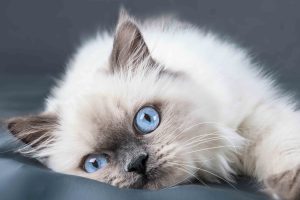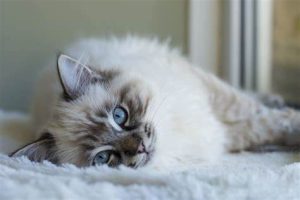Basic information about Ragdoll Cats
Ragdoll cats are a beloved and distinctive breed known for their striking blue eyes, luxurious semi-long fur, and gentle, affectionate nature. Here’s an overview of the Ragdoll cat breed:
Appearance
Ragdolls are large, muscular cats with semi-long fur that is soft and silky. They have striking blue eyes and distinctive pointed coloration, meaning their ears, face, paws, and tail are darker than the rest of their body. Ragdolls come in a variety of colors and patterns, including seal, blue, chocolate, and lilac, among others.
Personality
Ragdolls are famous for their sweet, gentle, and laid-back temperament, earning them the nickname “puppy cats” for their tendency to follow their owners around and greet them at the door. They are known for their affectionate nature and often enjoy being held and cuddled. Ragdolls are typically good with children and other pets, making them excellent family companions.
Origin
The Ragdoll breed was developed in the 1960s by breeder Ann Baker in Riverside, California. The breed’s foundation cat, Josephine, was a white domestic longhair with Siamese-like markings. Josephine was known for her exceptionally calm and docile temperament, and Baker selectively bred her offspring to create cats with similar traits, eventually establishing the Ragdoll breed. The breed gained popularity quickly. Other breeders began working with Ragdoll cats, and the breed was eventually recognized by major cat registries, including The International Cat Association (TICA) and the Cat Fanciers’ Association (CFA), in the 1960s and 1970s.
Name
The breed’s name, “Ragdoll,” is said to have been inspired by the cats’ tendency to go limp and relax completely when picked up, similar to a child’s ragdoll toy. This trait is often referred to as “floppiness” and is characteristic of the breed’s relaxed temperament.
Care
Ragdolls have semi-long fur that requires regular grooming to prevent mats and tangles. Weekly brushing is usually sufficient to keep their coat in good condition. Additionally, like all cats, Ragdolls require regular veterinary check-ups, proper nutrition, and a stimulating environment to thrive.
Health
Ragdolls are generally healthy cats, but like all breeds, they may be prone to certain genetic health conditions. These can include hypertrophic cardiomyopathy (a heart condition) and polycystic kidney disease. Responsible breeding practices, including health screening of breeding cats, can help minimize the risk of these conditions.

Ragdoll cats have become increasingly popular over the years due to their stunning appearance and gentle, affectionate nature. They make wonderful companions for families, singles, and seniors alike, providing love, companionship, and entertainment to their owners.
Lifespan
The lifespan of Ragdoll cats typically ranges from 12 to 15 years, although some individuals may live longer with proper care and attention to health. Like all cats, the lifespan of a Ragdoll can be influenced by various factors, including genetics, diet, environment, and access to veterinary care.
Providing a balanced diet, regular exercise, routine veterinary check-ups, and a stimulating environment can contribute to a Ragdoll’s overall health and well-being, potentially extending their lifespan. Additionally, responsible breeding practices that prioritize the health and longevity of the breed can help reduce the risk of genetic health issues that may affect lifespan.
As Ragdolls are generally healthy cats, with proper care and attention, they can live long and happy lives as cherished companions to their owners.

Today, Ragdoll cats are recognized as one of the most popular and beloved cat breeds, known for their docile temperament, striking appearance, and loving demeanor. Despite the colorful stories surrounding their origin, Ragdolls continue to capture the hearts of cat enthusiasts around the globe.
More posts you might be interested in:

